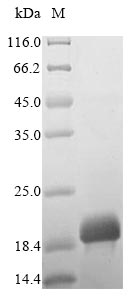Recombinant Tyrophagus putrescentiae Mite group 2 allergen Tyr p 2 is produced in E. coli and contains the full length of the mature protein, corresponding to amino acids 16-141. The protein includes an N-terminal 6xHis tag that makes purification and detection more straightforward. SDS-PAGE analysis confirms that this recombinant protein achieves purity levels exceeding 85%, which appears suitable for various research applications.
Tyrophagus putrescentiae Mite group 2 allergen Tyr p 2 represents a significant allergen from the mold mite that researchers often examine when studying allergic responses. This protein seems to play a key role in triggering immune reactions, potentially making it a valuable research tool. Studies typically focus on how it may be involved in immune response pathways and allergenicity testing.
Potential Applications
Note: The applications listed below are based on what we know about this protein's biological functions, published research, and experience from experts in the field. However, we haven't fully tested all of these applications ourselves yet. We'd recommend running some preliminary tests first to make sure they work for your specific research goals.
Tyr p 2 is a mite group 2 allergen, which typically belongs to the lipocalin family and may contain disulfide bonds or require specific folding for biological activity (e.g., IgE binding). E. coli can express some small eukaryotic proteins correctly, especially if they are simple and do not require complex post-translational modifications. No validation data (e.g., circular dichroism, activity assays, or IgE binding tests) are provided. Therefore, the protein's folding and bioactivity cannot be confirmed; it may be correctly folded or misfolded. Applications should proceed with caution until verified.
1. Allergen-Specific IgE Binding Studies
IgE binding depends on conformational epitopes; misfolding could disrupt these epitopes, making assays invalid without validation. If the recombinant Tyr p 2 protein is correctly folded and retains its native conformation, it can be used in enzyme-linked immunosorbent assays (ELISA) for examining IgE binding patterns in serum samples from people with mite allergies. The N-terminal 6xHis tag facilitates attachment to nickel-coated plates for standardized binding assays. Scientists can study cross-reactivity with other group 2 allergens. The high purity (>85%) supports reproducibility, but if the protein is misfolded, IgE binding may be altered or lost, leading to unreliable results, as conformational epitopes might not be preserved.
2. Monoclonal Antibody Development and Characterization
Antibody development can work with linear epitopes, but conformational specificity requires correct folding; unverified proteins risk generating non-functional antibodies. The recombinant protein can serve as an immunogen for producing monoclonal antibodies, even if misfolded, as antibodies may recognize linear epitopes. However, if correctly folded, antibodies generated will likely be specific to the native allergen, useful for hybridoma screening and binding studies. The defined expression region (16-141aa) represents the mature protein, but if misfolded, antibodies might not bind the natural allergen in biological contexts, limiting their utility.
3. Protein Structure-Function Analysis
Structural analyses assume native folding; misfolded proteins would provide misleading insights into function and stability. If the recombinant Tyr p 2 is properly folded, it is suitable for biophysical studies like circular dichroism spectroscopy, dynamic light scattering, and thermal stability assays to understand structural properties. The His-tag aids purification and concentration. However, if misfolded, such studies would yield inaccurate data on secondary structure and stability, potentially leading to erroneous conclusions about the allergen's native form.
4. Allergen Cross-Reactivity Mapping
Cross-reactivity studies rely on native protein conformation; misfolding compromises the validity of comparative binding data.If the protein is correctly folded, it can be used in competitive inhibition ELISA to study cross-reactivity with other mite allergens, leveraging the His-tag for attachment. This could help map epitopes and understand cross-reactive responses. If misfolded, competition assays may not reflect true biological interactions, as conformational epitopes might be absent, resulting in false negatives or positives.
Final Recommendation & Action Plan
It is essential to validate the folding and bioactivity of this recombinant Tyr p 2 protein before any application, as E. coli expression may not guarantee correct folding for this eukaryotic allergen. The action plan should include: first, performing folding assays (e.g., circular dichroism to check secondary structure) and functional tests (e.g., IgE binding ELISA using known positive sera); if the protein is misfolded or inactive, consider using a eukaryotic expression system (e.g., yeast) for re-expression or obtaining a commercially validated standard; until verification, applications should be considered preliminary and cross-validated with native allergens to ensure reliability.






